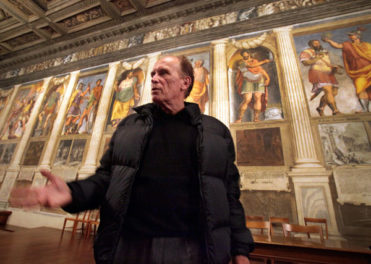
Gilo #1, 2001, Miki Kratsman. Digital print. Courtesy of and © Miki Kratsman
Border walls cause human suffering, damage the environment, and are overly simple solutions to complex problems. They’re also multiplying at an alarming rate. This was the takeaway from the recent Getty Museum symposium New Walled Order: The Aesthetics and Politics of Barriers, which brought artists, historians, writers, architects, and social scientists together at the Getty on the occasion of the 25th anniversary of the fall of the Berlin Wall and the opening of the exhibition Josef Koudelka: Nationality Doubtful.
Three walls of great notoriety—the Berlin Wall, the Palestine separation barrier, and the U.S. border fence—were the focus of day’s discussion. Though these walls are fundamentally unalike, they all reveal similar truths about our love-hate relationship with other people and ourselves. Here are ten takeaways from the day, with selected tweets from the event.
1. Walls are a recent phenomenon.
Walls have been around since ancient times, typically built for self-defense. Today’s walls are different; they protect against intangible fears as much as physical threats. They “close up or wall in the unknown, the misunderstood, the dangerous, and the miserable,” said keynote speaker Alexandra Novosseloff.
2. Democracies are today’s primary wall builders.
The iconic status of the Berlin Wall—built by a repressive regime and designed to keep its people captive—blinds us to the realities of today’s “barrier-industrial complex,” to use a term coined by Getty educator Peter Tokofsky. In our current world, most walls are built not by dictatorships but by democracies such as the United States, Israel, Spain, and India.
have we not learned from the berlin wall? there is the israel-palestine separation and usa-mexico border wall #newwalledorder @thegetty
— Tala (@tatulip) November 15, 2014
3. “Wall” is a dirty word.
Governments avoid using the word “wall,” mostly preferring the milder-sounding “fence” or “barrier.” The longest portion of the U.S. border wall, for example, is officially referred to as Vehicle Fence 300 (VF300). As architecture historian Ines Weizman shared, East German citizens were barred from referring to the Berlin wall as the Mauer, the German word for wall; instead, they were required to call it the antifaschistischer Schutzwall—literally, the “anti-fascist defensive rampart.”
Walls are both awful and spectacular. Beauty of horror, horror of beauty. #newwalledorder — Julia Sonnevend (@juliasonnevend) November 15, 2014
4. Walls are symbols of domination.
Beyond their physical function, walls serve as symbolic tools to “inscribe domination” on the land. “You not only impose control,” said photographer Miki Kratsman, “you show control.” Ines Weizman illustrated this point with a quasi-comical story about the arms race between the governments of West and East Germany to dominate the Berlin skyline in the 1960s. In this childish battle of ever-higher towers and ever-more-obstructed sightlines, the Berlin Wall became the most potent symbolic gun.
Now a tourist relic, Berlin’s TV tower was a GDR ploy to rule the skyline —Ines Weizman @bauhaus_uni #NewWalledOrder pic.twitter.com/s7TG2I50Jj
— The Getty (@thegetty) November 15, 2014
5. Walls want to be invisible.
As walls grow longer and taller, they also grow blander in a bid to fade into obscurity. “The American wall is invisible,” said French photographer Maurice Sherif, “because it has no personality.” Israeli photographer Miki Kratsman spoke about his art students, only a few of whom recall seeing the Palestine barrier—even though it is visible from the cafeteria of their own school. In the United States and Mexico, added urbanist Michael Dear, the border wall is invisible not simply because it is physically remote, but also because it is psychologically remote. Simply put, most of us don’t care to notice.
What would change if we saw people on the other side of the border as part of our community? —Michael Dear @CEDNews #NewWalledOrder — The Getty (@thegetty) November 16, 2014
6. Walls have two very different sides.
Physically and psychologically, walls create two distinct jails, but, in the words of Josef Koudelka, “the quality of the jails is not the same.” It is therefore no surprise that on wall after wall, protest graffiti is emblazoned on the “bad” side.

San Luis, Arizona from The American Wall series, Maurice Sherif. Courtesy of and © Maurice Sherif
7. Walls are less important than the human systems built around them.
Walls are patrolled, electrified, extended, tunneled through, argued about, and fortified, and it’s this human activity around the physical barriers that makes them so fraught. As Eyal Weizman commented while discussing the Palestine separation barrier, “you cannot call for the wall to come down, because there is another wall behind it, and another wall behind that.” Likewise, historian Julia Sonnevend pointed out that the real horror of the Berlin Wall was not the physical wall but the regime of fear and surveillance symbolized by the police, attack dogs, and trip-wire machine guns stationed along the adjacent death strip.
Walling and unwalling are complementary acts of spatial control – Eyal Weizman #NewWalledOrder
— Julia Sonnevend (@juliasonnevend) November 15, 2014
8. Walls always fail.
Speaker after speaker stressed the same point: Walls don’t stop movement; they only make it more dangerous. Armed with human ingenuity, people always find a way over, around, under, or through. “As an architect,” said Eyal Weizman, “I could demonstrate that every attempt at separation is absurd.”
Flying over the wall #US-MexicanBorder #Newwalledorder @TheGetty pic.twitter.com/Jwoo2AAVmx
— MursEntreLesHommes (@MursWalls) November 16, 2014
9. Walls fall slowly, but are forgotten quickly.
“There was no Berlin Wall and it never fell.” So reads the first sentence of Julia Sonnevend’s forthcoming book on Berlin. As she pointed out, the wall was only one part of a large-scale, complex border regime that took years to demolish. And yet, when a wall finally falls, so does its memory. Half the current population of Berlin has no personal recollection of the wall, said Sonnevend. German artist Christof Zwiener picked up on this theme, sharing his concern about the near-complete physical dismantling of the past in East Germany. Although pieces of the wall remain, its violent trappings have disappeared. One poignant example: the death strip segment featured at the new Berlin Wall Memorial is entirely reconstructed. Where did the curator find the watchtower now on display at the memorial? eBay.
Traces of German #history are being destroyed. As an artist I must stand against this —C Zwiener #NewWalledOrder pic.twitter.com/epeolW0FEu
— The Getty (@thegetty) November 15, 2014
10. Walls are an admission of failure.
“A wall is built each time a culture or civilization has not been able to think the other, to think with the other,” Alexandra Novosseloff said. They represent the failure of politics and dialogue. A wall is a simple snapshot of the problems of the world, Gregory Rodriguez of Zócalo Public Square remarked in summing up the day. It’s a picture that leads to disillusionment for both sides.
One audience member asked the question on everyone’s mind: how can we put an end to walls? Stop hating, and stop teaching hate. And that, of course, is a lot harder than tearing down a wall.
One of the conclusions of todays great conference: Walls can only simplify complex problems @thegetty #newwalledorder
— MursEntreLesHommes (@MursWalls) November 16, 2014




Today’s walls are built for the same reason as ancient walls – self-defense! Self-defense of no new taxes to “care” for people who cross borders illegally. Democracies build walls more you say, Dictatorships just annihilate the people, which is not nicer as implied in your post.